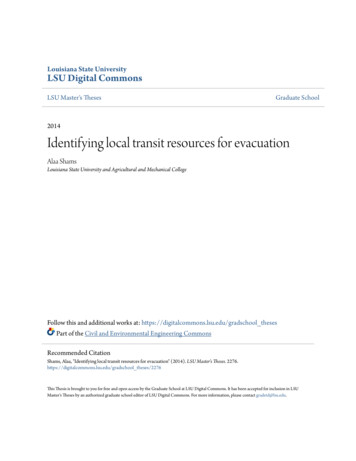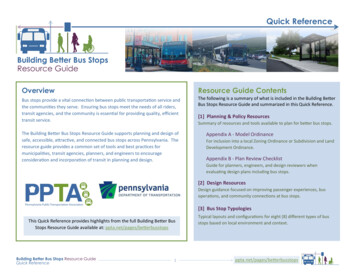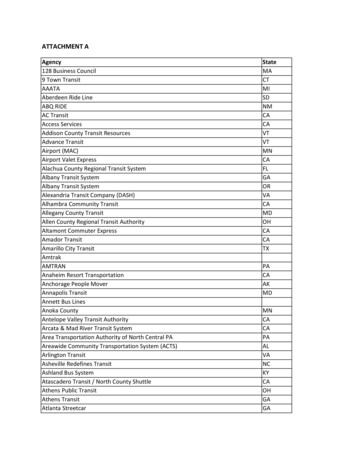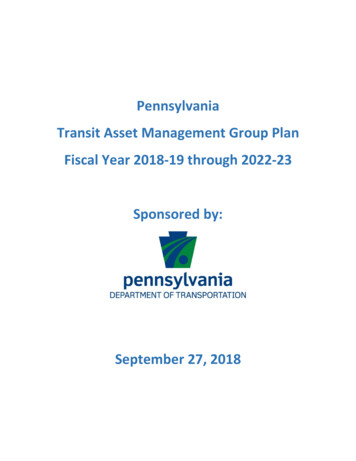
Transcription
Louisiana State UniversityLSU Digital CommonsLSU Master's ThesesGraduate School2014Identifying local transit resources for evacuationAlaa ShamsLouisiana State University and Agricultural and Mechanical CollegeFollow this and additional works at: https://digitalcommons.lsu.edu/gradschool thesesPart of the Civil and Environmental Engineering CommonsRecommended CitationShams, Alaa, "Identifying local transit resources for evacuation" (2014). LSU Master's Theses. 2276.https://digitalcommons.lsu.edu/gradschool theses/2276This Thesis is brought to you for free and open access by the Graduate School at LSU Digital Commons. It has been accepted for inclusion in LSUMaster's Theses by an authorized graduate school editor of LSU Digital Commons. For more information, please contact gradetd@lsu.edu.
IDENTIFYING LOCAL TRANSIT RESOURCES FOR EVACUATIONA ThesisSubmitted to the Graduate Faculty of theLouisiana State University andAgricultural and Mechanical Collegein partial fulfillment of therequirements for the degree ofMaster of ScienceinThe Department of Civil and Environmental EngineeringbyAlaa ShamsB.S., Damascus University, 1998M.S., Southern University, 2004May 2014
To my son Adam Alaa Shams the joy of my lifeTo my parents, family and friendsTo the free Syrian people.I dedicate this thesisii
ACKNOWLEDGMENTSI would like to thank all my committee members for all the patience and the help thatthey offered during the time I spent in the graduate school at Louisiana State University. Also Iwould like to thank Dr. Wilmot specifically for offering me a graduate assistantship to work onthis particular project to write this thesis. I also would like to extend my thanks to all mycolleagues, family members and my friends for their love and support for the past couple ofyears. Special thanks to Navigation Electronics, Inc. in Lafayette, LA to make my dream cometrue.It is been a tough journey, but I can assure you that I worked very hard to earn thismaster’s degree. Always remember not to give up because there is always a hope and a light atthe end of the tunnel, never lose your faith in yourself and be strong. Always dream big and workhard toward your dreams no matter how big they are.iii
TABLE OF CONTENTSACKNOWLEDGMENTS . iiiLIST OF TABLES . viLIST OF FIGURES . viiABSTRACT . ixINTRODUCTION . 1OBJECTIVES . 2REVIEW OF LITERATURE . 3METHODOLOGY . 6Choice of GIS platform . 6GIS at DOTD . 6ArcGIS Online . 8Establishing an ArcGIS Account . 10Choice of Spatial Unit . 10LA DOTD Parish Boundaries . 11Census Blocks . 12Census Block Groups . 14Traffic Analysis Zones (TAZs) . 15TAZ/Block Group Overlay Intersect . 15Coastal Zone Boundary (2012) . 16DATA . 17Collection . 17Socio-Demographic Data . 17Family Independence Temporary Assistance Program (FITAP) . 17Supplemental Nutrition Assistance Program (Food Stamp Program) (SNAP). 19ANALYSIS . 20Using ArcGIS Online . 20Analysis . 23Private Schools. 23Public Schools. 24Private Universities . 25iv
Public Universities . 25Human Services Transportation Stakeholder . 26Retirement Homes . 29Department of Health and Hospitals . 30HSS-NEMT Facilities . 31HSS-HCBS List . 31Non-Emergency Shelters. 32Veteran Homes. 32Transportation Resource Guide . 34TAZGB. 36SUMMARY AND CONCLUSIONS . 40REFERENCES . 42VITA . 43v
LIST OF TABLESTable 1 Coastal Parishes of Louisiana . 12Table 2 Number of vehicles query results . 39vi
LIST OF FIGURESFigure 1 Coastal Parishes of Louisiana . 11Figure 2 Census Blocks in Coastal Parishes of Louisiana . 14Figure 3 Census Block Groups in Coastal Parishes of Louisiana . 14Figure 4 Traffic Analysis Zones in Coastal Parishes of Louisiana . 15Figure 5 TAZBGs in Coastal Parishes of Louisiana . 16Figure 6 Louisiana Coastal Zone Boundary . 16Figure 7 FITAP Recipients by Census Block in Coastal Parishes. 18Figure 8 Food Stamp Recipients by Census Block in Coastal Parishes of Louisiana . 19Figure 9 ArcGIS Online Web Site . 20Figure 10 Sign In to ArcGIS Online . 21Figure 11 ArcGIS Online Portal at LSU . 22Figure 12 LSU ArcGIS Online Users . 22Figure 13 Adding Data Files to ArcGIS Online . 23Figure 14 Private Schools in Coastal Parishes of Louisiana. 24Figure 15 Public Schools in Coastal Parishes of Louisiana . 24Figure 16 Private Universities in Coastal Parishes of Louisiana . 25Figure 17 Public Universities in Coastal Parishes of Louisiana . 26Figure 18 HST Stakeholders in New Orleans Area . 27Figure 19 HST Stakeholders in Houma Area . 28Figure 20 HST Stakeholders for Lake Charles Area . 28Figure 21 Retirement Facilities in Louisiana . 29Figure 22 Health Care Facilities in Louisiana . 30vii
Figure 23 Non-Emergency Medical Transportation Providers . 31Figure 24 Home and Community Based Service Organizations . 32Figure 25 Non-Emergency Shelters . 33Figure 26 Veterans Homes. 33Figure 27 Transit Resources Guide Data . 34Figure 28 Query on Transit Vehicles at a Location . 36Figure 29 Query on Population in an Area . 37Figure 30 Viewing the Attribute Table of a Layer . 38Figure 31 Attributes of an Area . 39viii
ABSTRACTThe objective of this thesis is to establish a GIS that can be used to identify local humanservices and special-needs transit resources in Louisiana’s 20 coastal parishes. The intention isthat the system be used to identify and then call upon local transit services to assist in theevacuation of an area during an emergency. ArcGIS Online was selected as the platform onwhich to establish the GIS for this purpose. Socio-economic and transit vehicle data werecollected from a variety of official sources and loaded on to the ArcGIS Online portal at LSU.The development of the system is described in this thesis. Its ability to provide graphical outputof the underlying data is demonstrated, including the ability to easily and quickly determinetransit resources residing at a point, within a buffer surrounding a point, or within a polygondrawn by the user.ix
INTRODUCTIONAlthough there are many different “on demand” transit systems managed by several stateagencies with different federal funding that will provide transportation to various categories ofriders such as the elderly, low-income, veterans, disables, and those needing access jobs;currently, there is no single means of identifying all these local resources (drivers and vehicles)and yet, with sufficient organization and collaboration, these resources could be leveraged toaddress localized transportation needs, particularly during an emergency. Louisiana legislatureestablished a working group to create coordination and collaboration among these agencies andproviders, but most were not sufficiently motivated to put their full weight behind the effort.However, if the call to collaboration is to provide life-saving support during an emergency, andthey see sufficient benefit to themselves and those they serve, these agencies may be motivatedto commit more earnestly. Inventorying and assessing the capabilities of the various humanservices transportation providers operation in the state would aid in coordinating resourcesduring and after evacuation events, support transportation efficiencies and mobility year round,and could result in significant cost saving to the state and local authorities.This thesis addresses the incorporation of data of local transit resources and the users ofthese systems into a Geographic Information System (GIS). The purpose of the GIS is to providea convenient platform from which emergency managers can identify local transit resources aswell as local transit demand in times of an emergency. The local transit resources will be used,primarily, to evacuate human services and special needs patrons that they usually serve, but may,in a special crisis, be called upon to support the evacuation needs of the general public becausetheir proximity and ubiquity may allow quicker service than other systems.1
OBJECTIVESThe primary purpose of this study is to establish a GIS which officials of the LouisianaDepartment of Transportation and Development (LA DOTD) and Emergency Managers of theGovernor’s Office of Homeland Security and Emergency Preparedness (GOHSEP) can use toidentify local human services and special needs transit resources in Louisiana’s 20 coastalparishes. These then can be called upon to serve evacuation needs in an emergency. A secondarypurpose is to identify the demand that is likely to need the resources identified.The system must be capable of being accessed remotely from multiple sites, withminimum training of the users in the utilization of the system. The system must also be capableof providing information quickly so that the delay in providing emergency services is minimized.These requirements are motivated by the fact that in an emergency, users of the system likely tobe located at more than one location, would be able to initiate independent and maybe nearsimultaneous queries and are likely to be unskilled in the use of GIS systems.The objectives of the study can be summarized as:(a) Consolidate information on transportation assets in the public, private, and state sectors tofacilitate the movement of and transportation support of special or human servicetransportation need citizens in Louisiana’s 20 coastal parishes during an emergency ordisaster.(b) Identify the number of passengers currently served by special or human servicetransportation services.(c) Incorporate information from (a) and (b) above into a GIS capable of queryingevacuation demand and transit supply by geographic area in the 20 coastal parishes ofLouisiana.2
REVIEW OF LITERATUREThe use of Geographical Information Systems (GIS) in transportation dates back to theearly use of GIS in the 1980s. It has been used in a variety of ways in transportation where itsability to present spatial data graphically has made it a popular choice of data managementamong transportation professionals. In transit, its use has primarily been in characterizing thepopulation that potentially could be served by transit, or in graphically presenting the servicebeing provided. For example, Orange County Transportation Authority (OCTA) in southernCalifornia uses it to map the demographic characteristics of the population within walkingdistance of its routes such as the number of senior citizens, children under the age of 17, personswith disabilities, and households not owning a vehicle (US DOT, 2001). In their application ofGIS, it is used in planning new routes, and then presenting the information to patrons in terms ofmaps and the opportunity to view schedules and initiate queries.Following Hurricane Katrina in 2005, Congress commissioned a study by theTransportation Research Board on the role of transit in emergency evacuation (TRB, 2008). Acommittee of 11 people from industry, practice, and academia prepared a report on how best toprovide mobility to persons in large urban areas in the United States using transit during anemergency. They concentrated not only evacuation but on the whole question of mobilityincluding the ability provide entry of emergency staff, supplies, and equipment during theemergency as well as the re-entry of the population once the emergency has passed.The question of human services and special needs transit has long received attention onthe matter of coordination (Burkhardt et al., 2004). So many agencies provide transportation forhuman services and special needs passengers that coordinating these services would providelarge improvements in efficiency (Enders and Seekers, 2011). However, while there have been3
many appeals from federal government and state agencies to achieve coordination andcollaboration, only isolated cases of joint activity have been achieved (Seekins et al., 2007). Acurrent study being conducted by the Louisiana Transportation Research Center, which thisthesis is part of, is aimed specifically at achieving collaboration among human-services andspecial-needs transit providers during an emergency because it is believed that collaboration ismore likely to be achieved during an emergency than under normal circumstances. Having aninventory of transit vehicles owned by the human services and special needs agencies in thecoastal parishes of Louisiana will allow a state agency such as the Governors Office ofHomeland Security and Emergency Preparedness (GOHSEP) to call upon individual agencies toprovide transit service once agreement on mutual assistance to participating agencies is obtained.The matter of the expected demand that will arise during an emergency is a topic of interest inthis study. One of the issues pertaining to identifying demand for evacuation is the migrationalmovement of people. That is, at any time during the day or week people change their location asthey go about their regular activities – going to work, school, shop, or social/recreationalactivities. Thus, depending on when an emergency occurs, people are likely to be at differentlocations depending on the time of day, day of week, or even the season. This concept ofincluding the time element into cartographic information was introduced in the 1980s (Langranand Chrisman, 1988; Peuquet, 1994). Three methods of representing time in spatial analysis wereused: time-slice snapshots, base map with overlays, and space-time composite (Langran andChrisman, 1988). In space-time composite maps space is shown, as usual, in terms of a point oran area on the map while time is depicted thematically in terms of color or hue. Thus, forexample, areas of different land use can be shown as polygons on a map while the variation intheir population can be shown by change in color or variation in hue of a specific color.4
Although some research has been conducted on the temporal population distributionduring an emergency (Freire and Aubrecht, 2012) most studies have been conducted to estimatethe temporal distribution under normal circumstances. Typically, this involved using officialstatistics such as the census for nighttime population distribution (McPherson and Brown 2004)and then estimates of workers, students, and shoppers per household to estimate daytimepopulation in residential, commercial, industrial, and other neighborhoods. Work locations andnumber of workers were estimated from data in business directories. Numbers of workers at thehome end were obtained from census county-to-county journey to work data.5
METHODOLOGYChoice of GIS platformOne of the first tasks was to identify a GIS that suited the needs of the project.Specifically, the system had to be accessible to LA DOTD and GOHSEP officials, had to becapable of handling multiple users simultaneously, and had to be user friendly. During thereview process we came across multiple platforms used by different state departments inLouisiana and we studied them in detail to determine the pros and cons of each system. Thetwo systems that promised to provide the best match to our requirements were the GISsystem operated by LA DOTD and ArcGIS Online, a commercial program developed byESRI (Environmental Systems Research Institute) the well-known developer of the GISArcINFO.GIS at DOTDThe GIS at LA DOTD operates within the department’s Web Application DevelopmentSystem. The system was developed by LA DOTD’s IT Section and has implementedstandards for all web applications. Any web application developed for DOTD must complywith their software standards. By meeting these standards, contractors and developers ensurethat their work will be compatible with the existing DOTD IT infrastructure. Contractdeliverables that do not comply with these standards cannot be assimilated into the DOTD ITsystem. In addition, applicable State of Louisiana Office of Information Technologystandards also apply.Some of the requirements for the Development Environment Standards for LA DOTD’sWeb Applications include:6
Web Server OS: Microsoft Windows Server 2008 with IIS7. All web application must becompatible with this OS. Development IDE: Microsoft Visual Studio 2008 SP1. Applications must be delivered inthe form of a Visual Studio, non-compiled solution including licensed copies of alldependent libraries and become the property of LA DOTD. Approval and Registration of 3rd Party Components: All third party libraries must beapproved and registered in the name of LA DOTD. Software Standards for DOTD Web Applications: All web applications must be builtwith ASP.NET and the .NET 3.5 SP1 Framework (or newer) using the Visual Basic.NET Programming language. ASP.NET MVC is not an approved framework. The AJAX Control Toolkit Library may be included in any web application. All Intranet web applications must be viewable and fully functional in Internet Explorer 7and above. All public web applications must be viewable and fully functional in all majorweb browsers. Database Standards for DOTD Applications: DOTD web applications must use DB2 asthe standard database management system. Approval to use Microsoft SQL Server willbe given on an individual basis. Documentation: Specific documents will be identified in the contract. User Guide must be available online from within the application All design documents, installation instructions, and implementation guides must bedelivered with the application Development: DOTD will provide the Master Pages and Style Sheets for webapplications.7
DOTD Standards must be followed in all web applications. The standards documents willbe made available on a need to know basis. Applications developed on site must follow the DOTD software development life cycleand other DOTD processes. Applications developed offsite must follow these guidelines: The Contractor will providea scope of work to IT at the beginning of the project. The Contractor will involve theapplications clients in all requirements gathering sessions. The Contractor will adhere toLA DOTD’s Web Standards and Best Practices. The Contractor will deliver all sourcecode at least once a month to LA DOTD. LA DOTD will then perform code reviews tovalidate web standards and best practices are being followed. The Contractor willperform adequate testing before the solution is transitioned to LA DOTD. This includesbut is not limited to unit tests, functional tests, integration tests, performance tests, anduser acceptance tests. LA DOTD IT personnel must be involved in all testing. For solutions that will be hosted by LA DOTD, the solution must be deployed to the LADOTD staging environment where tests will be executed against LA DOTD test data.The Contractor must provide documentation of the steps required to deploy the solution.The LA DOTD project manager will be responsible for the deployment. The Contractorwill be responsible for fixing all defects prior to transitioning the project to LA DOTD.ArcGIS OnlineIn contrast to the LA DOTD GIS system, ArcGIS Online has few user requirements andis easy to use. It operates on a computer housed at ESRI headquarters in California with useraccess to the system through the Internet. LSU is a licensee of ArcGIS Online and has aserver which manages local use and authorizations to perform different functions on the8
system such as use of ArcGIS Online, storage of data, sharing of information, and providingaccess to other users. Data can be hosted in ESRI’s secure cloud or on our own server.Multiple layers of security protect data from unauthorized access. Ownership of data ismaintained and the user controls who can access data and maps. The user does not need toconcern him/herself with software, hardware, security, or maintenance of the system. Eachuser gets an account and may share data or collaborate with other users on joint projects.Users also have access to ready-to-use apps, maps, templates, and other content so they canbecome productive more quickly. The system allows the monitoring of events, activities, andassets through interactive dashboards and maps, images, and scenarios may be shared withothers or combined with your own data to provide enriched information.With spatial analytics, you can use geographic relationships to gain understanding andmake better decisions. In the particular case being investigated in this project, namely theidentification of human services and special needs transit resources that could be used forevacuation in emergencies and the demand that may arise to make use of these services, thesystem can be used to estimate which locations lack resources or which areas are likely tohave more people that need to be evacuated.ArcGIS Online includes ready-to-use base maps, demographics, imagery, and map layers.They are created with authoritative content from commercial data providers and contributionfrom the GIS user community. Of particular value to the project addressed in this study aretools such as geocoding and the ability to extract data with web maps and apps. Developerscan access them by using ArcGIS API’s and SDK’s to build web and mobile applicationsthat meet specific workflows such as evacuation strategies planned in this project.9
ArcGIS Online allows customization of roles or privileges assigned to members within asingle account. This administrative capability allows the assignment of roles that specificallyfit our situation, the way we work, and the functionality we want people to be able to use. Forexample, we might have some members who need access to our maps and apps but do notneed to create groups. Or we might have other member who needs to publish features but notfiles.Establishing an ArcGIS AccountAn ArcGIS Online account was established under the site license for the software atLouisiana State University. The author was assigned publisher privileges in the accountmeaning that he can add and analyze data. Users can be added to the account so that they canaccess the system and conduct queries but they are not allowed to add or manipulate data inthe databases in ArcGIS Online. ArcGIS Online has a limit of 1000 features per layer,meaning that those files that contained more than 1000 features, had to be broken up intoseparate files.Choice of Spatial UnitWithin the data, the smallest geospatial units at which most of the data needed in thisstudy was available were Traffic Analysis Zones (TAZs). TAZs are established byMetropolitan Planning Organizations (MPOs) as part of their urban planning requirements.Data from the American Community Survey is used to populate the TAZs with aggregatedemographic data. However, TAZs tend to be small (geographically) in urban areas and largein rural areas because the emphasis is on urban rather than regional planning. Since somehuman services transit is in rural areas a more uniform set of geographical units was soughtin this project. To addre
Louisiana State University LSU Digital Commons LSU Master's Theses Graduate School 2014 Identifying local transit resources for evacuation . It has been accepted for inclusion in LSU Master's Theses by an authorized graduate school editor of LSU Digital Commons. For more information, please contactgradetd@lsu.edu.










